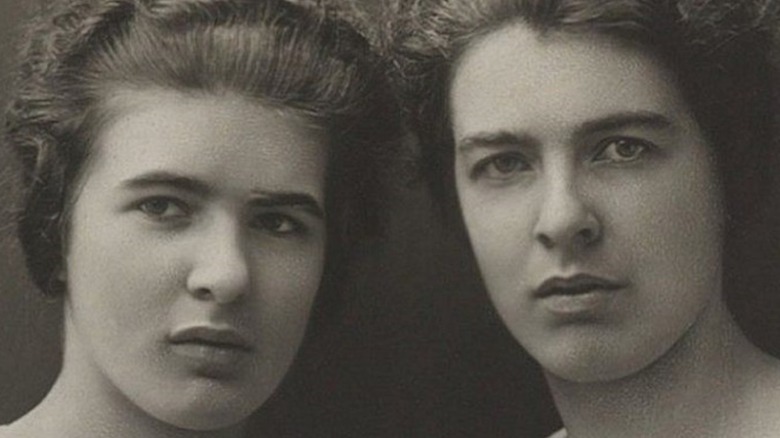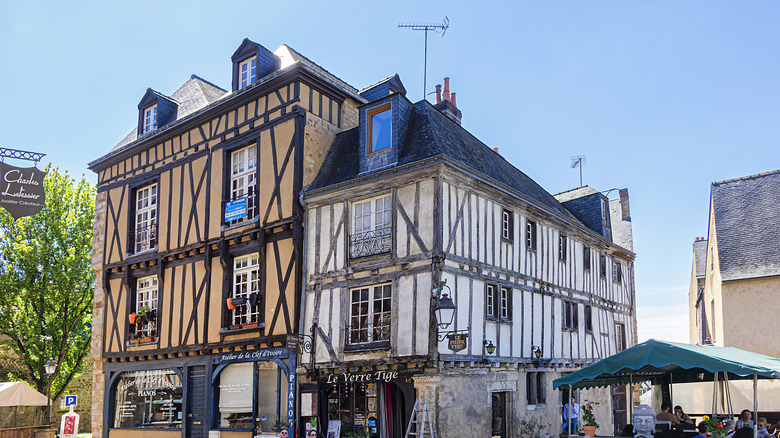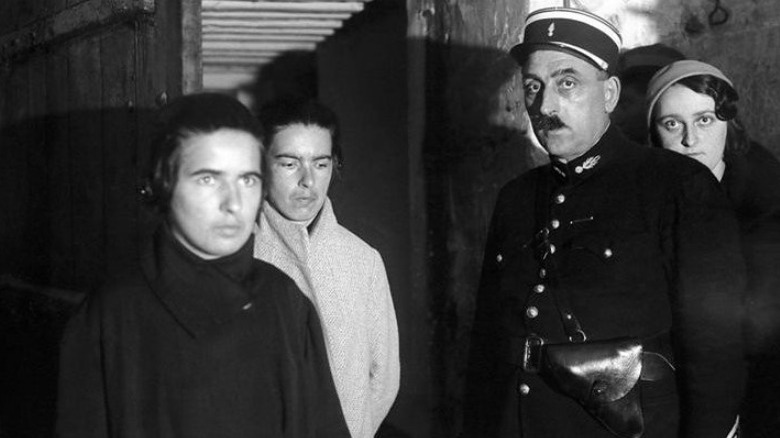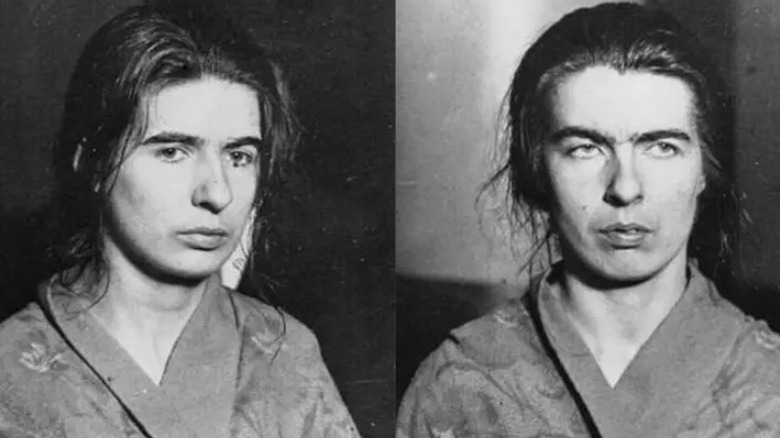The Papin Sisters' Troubling Crime Brought New Meaning To The Word Gruesome
The two Papin sisters were born in Le Mans, France, in the early 20th century, according to Historic Mysteries. Christine was born in 1905, and Léa was born six years later in 1911, per The Line Up. They spent some of their childhood living with relatives, and Christine briefly lived in an orphanage too, but their mother usually demanded that they try to find work to support their family (via Crime Magazine). It was at one of their jobs that they committed a horrific murder so gruesome that it is still talked about more than a century later.
Per All That's Interesting, when the girls grew older, they took jobs at the Lancelin household, working for a retired lawyer, his wife, and his adult daughter. In 1926, when Christine was 22 years old, and Léa was about 16 years old, the two moved into the Lancelin house, where they made about the equivalent of $2,000 U.S. dollars per year (via Crime Magazine).
Life with the Lancelins
The Papins were apparently quite good at their jobs, and the Lancelins treated them well, giving them hot meals and letting them board in a heated room, as All That's Interesting reports. Per Film Daily, Christine usually did the cooking, while Léa was in charge of keeping the household clean and orderly.
But they did work up to 14 hours per day, according to The Line Up. And as for time off, they were allowed just one half-day each week. Aside from going to weekly church services, the girls tended to isolate themselves from other people, and spent most of their time together (via Film Daily). And although the sisters had adequate room and board, Léonie was very strict about keeping the house clean, and did "white glove tests" to check for dust and dirt.
And there was one odd thing — the Papins had never actually seen their employer, René Lancelin (via All That's Interesting). The lawyer's wife, Léonie, and his daughter, Geneviève, interacted with the Papins, but the Papins never saw or spoke to René.
A blown fuse and broken iron
All That's Interesting reports that the Papins went out shopping, where they also retrieved a broken iron from a repair shop. Léonie and Geneviève went shopping on their own, and then had planned to meet René that evening for dinner.
When the Papins got back to the house, they tried to plug in the iron, but it was still broken, and caused a fuse to blow out. But they weren't expecting the Lancelin family to be back until quite late that night, so they figured the iron could be dealt with the next day. With the fuse blown, the house was in full darkness.
However, Léonie and Geneviève stopped back home the evening of February 2, 1933, after their shopping trip (via The Line Up). And Léonie was furious to see a dark house and no servants around. As the Papin sisters tried to explain to her why the power was out, and the iron was broken, they claim Léonie got whipped up into a fury. Léonie reportedly began to attack the siblings — and the Papin sisters fought back.
Locked out
Hours later, René was confused — his wife and daughter hadn't shown up to their dinner (via The Guardian). He returned to his two-story house to find he was locked out, but he saw a light on in the attic, where the Papins and other aides lived. Unable to get into his home, René contacted the police.
When he finally got into his home, René and the police couldn't believe their eyes at the horrifically grisly scene in front of them, according to The Line Up. As they would later learn from the Papin siblings, the sisters had fought back, and gouged the eyes out of Léonie and Geneviève's skulls. The sisters kept attacking them, hitting their employers with a hammer and a pitcher made from pewter.
One of the Papin sisters retrieved a knife from the kitchen, and they stabbed the now-blinded Lancelins. As a particularly horrific detail, the bodies appeared to be "scored" like loaves of bread, which may have been Christine's doing, since baking was her daily chore.
Aftermath of the murders
Christine began to prepare the bodies in the same way she prepared rabbits to cook (via Crime Magazine). Adding final insult to injury, the sisters lifted up the skirts of their employers over their heads and sliced them. Then they reportedly smeared Geneviève's period blood on her and her mother — as though they were basting a rabbit to cook, as Christine later admitted.
The Line Up reports that the Papins turned off the lights, locked the doors, and retreated to their room. As another unsettling detail, it was strongly believed that the Papin sisters were in a long-term incestuous relationship. When police found the sisters, they were naked in bed together by candlelight. The hammer that they'd killed with was also in the room, still covered in human remains.
Police next found the eyeballs of the Lancelins; Léonie's eyes were wrapped inside her scarf, and Geneviève's eyes were found in two places, on the stairs and under her body (via The Line Up). Both bodies were reportedly so mangled that it was hard to tell who was who. There were teeth scattered about the room, Film Daily reports, and Geneviève had cuts across her legs and backside.
Courts decide on the Papin case
After she was arrested, Léa reportedly told police that she would never speak of the case (via The Guardian). But Christine did confess, reports Crime Magazine, and Léa agreed with the details Christine doled out. The fervor around the case was intense: while the girls testified, police officers needed to control the crowds outside the courthouse.
While they first argued insanity, the court decided the girls were sane when they committed the double murder. Léa was sentenced to a decade of hard labor, while Christine, who had apparently influenced her little sister, was sentenced to a public death by guillotine.
While waiting for her execution, Christine was held in a prison cell, where she quickly deteriorated — she only wanted to see her sister. She reportedly tried to claw her own eyes out; a straight-jacket seemed to help a bit, but Christine told a judge that she was having bad mental episodes without her sister.
What happened to Christine and Léa?
But when the sisters met, Christine (above, left) reportedly opened her shirt to expose herself to Léa, and called out to her in a sexual nature, reinforcing the belief that they had an incestuous relationship (via Crime Magazine). They were separated again, and Christine was resentenced to life imprisonment at hard labor. She was later transferred to an insane asylum, where she starved herself to death, dying in May 1937.
Léa was freed after serving eight years of hard labor. She started working as a hotel maid under an assumed name, and died after a long life, either in 1982 or 2001 — sources disagree on the exact date.
The Guardian reports that the Papin sisters' story caused an immediate media firestorm, as people questioned why the sisters acted so brutally, and what their case meant — was it some form of mental illness, or was it actually about workers' rights? There were numerous books and movies written about or inspired by the gruesome acts of the Papin sisters (via The New York Times). They continue to intrigue writers and worker's rights advocates to this day.






